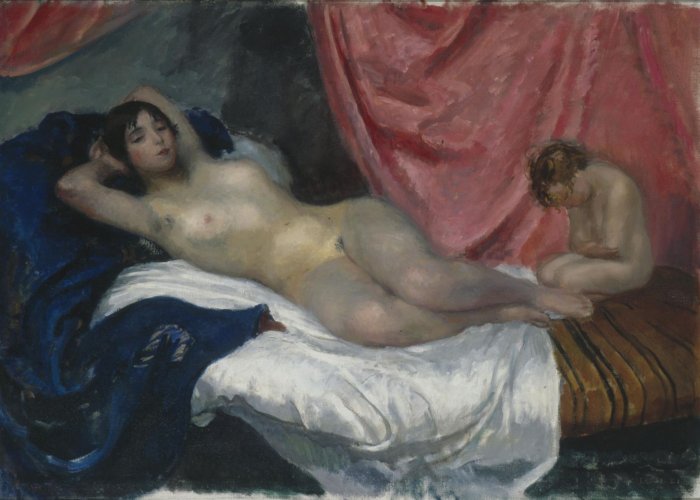Description:
Wojciech Weiss (1875-1950), known as a virtuoso of painting and female body, created works out of passion. He painted for the sheer pleasure of painting. He rarely asked his models to take artificial poses. He wanted to capture them in the most natural, real way. “Weiss does not look for action or philosophical meditation or geometric considerations or architecture…he does not turn women into columns – he simply wants to paint them in the light of their bodies – like a flower picked, like a ripe fruit thrown among clouds of fabric! Like a jewel in a dead nature! Create ever new orchestrations of body colors and harmonize them with the surroundings of draperies! – Like Titian and Tintoretto – illuminating the background of his paintings with the pearl of a lying body […] Paint white bodies of the lying Venus”*.
Wojciech Weiss has been painting nudes from the very beginning of his artistic career. It should be noted, however, that in the first stage of his career, male nudes were mainly depicted on canvas. It was only from around 1911 that women, presented in various perspectives, in outdoor settings, in closed rooms and at different times of day, began to dominate the artist’s work**.
Description of the painting:
The artist presents us with the interior of a female boudoir. In it, on the bed that fills the entire space, lies a naked woman. Her arms raised, she has placed them under her head. Her slightly squinted eyes look attentively straight ahead. Her legs are bent, knees turned towards the viewer. The compositional scheme is perfectly known and repeated in painting since the 16th century: “Sleeping Venus” by Giorgione, “Venus of Urbino” by Titian, “Olympia” by Manet, which shows that he studied the works of old and modern masters in detail. And yet there is something special in Weiss’s work. It shows the beauty of the female body. Its color scheme, the reflection of light on it, and the background of curtains surrounding it from all sides, give it an almost tangible texture of corporeality. The delicate, harmonious lines of the naked silhouette are multiplied in the disordered folds of the fabric from which the model seems to emerge on the painting. The dark blue and white fabric lying on the bed visually corresponds to the color of the foamy water from which the goddess of love – Venus – was born. The composition of the presentation and the figures portrayed in it make Rogalin’s “Temptation” by Weiss often referred to as “Venus and Amor”.


